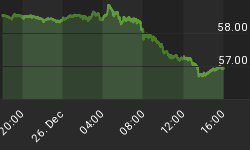The Iron Ages began over three thousand years ago and a major expansion of iron's use is the earliest of waypoints on the road to industrialization. The market for iron is far larger than that of the other heavy metals and it is essential for creating our modern network of bridges and skyscrapers. Despite this, the metal is not the stuff of daily news like "Dr." copper. The heavy growth in Asia generated a massive expansion of global iron ore production in the last decade. Based on figures compiled by South Africa's Creamer Media, iron ore production rose 65% between 2003 and 2008 to over 1.7 billion tonnes (Gt). Estimates called for iron ore output to top 1.9 Gt by the end of last year. By comparison, while finished copper output rose by nearly 20% during the '03-'08 period, mine output of copper rose by 5% during to 15.5 million tonnes (Mt).
China managed to triple iron ore output to 366 Mt during that period, India better than doubled output to 217 Mt, and the balance of the expansion came largely from Australia and Brazil that each produced close to 350 Mt in 2008. Most of the smaller producers also had some gains to output, however Canada's iron ore tonnage actually dropped during this major expansion to total 32 Mt in 2008. Canada's main iron ore ranges are in the east and too distant from Asia to have participated in this growth surge, until now.
When we noted the deal penned between mine developer Cons Thompson (CLM-TSX) and China's Wuhan Iron and Steel (WISCO) in March of 2009 we recognized it could represent a major reawakening of the Labrador Trough iron ranges. The first 8 Mt/year phase of output by Cons Thompson that began late last year by itself represented 25% of Canada's total iron ore output in 2008. Cliffs Natural Resources (CLF-N) that is taking over Cons Thompson is also expanding its own operations in the district, as is Arcelor Mittal (MT-N) which has become the world's biggest steel maker through a series of mergers over the past decade. Rio Tinto (RIO-N) which is a major player in the Australian iron ore sector also operates out of Labrador City. All of this senior company activity, and the resource expansion by some explorers like Champion Resources (CHM-TSX), has been focused in the southern Fermont part of the belt that is Canada's main iron ore district.
The Fermont expansion has so far been about filling up the existing rail infrastructure to port facilities on the Gulf of St. Lawrence that have recently begun an expansion. This district ships ore concentrates and that is some times rolled into pellets to coarsen material from ore that required fine grinding. The ore bodies are large taconite deposits containing around 30% iron. The Fermont district had to eke out a living during the period of low iron prices prior to 2005 by maintaining some shipments to the North American rusting foundry sector. Now, with a 600% price gain for its product since 2005 these operations have become highly profitable, and since they are also within existing infrastructure with excess capacity also highly desirable.
During the Labrador Trough's first heyday its second major district operating was around Schefferville at the northern end of the rail lines linking the iron mining districts to coastal shipping. The Schefferville area generated direct shipping ore (DSO) prior to 1983 for the Iron Ore Company of Canada (IOC), a consortium that still has Fermont district operations now run by Rio Tinto. Direct shipping ore approaches 60% iron content and requires lower mine site capital and processing charges, but the long transport charge to the coast sidelined this district. The Schefferville district is to again ship DSO in 2011 from the former IOC site now owned by start up company Labrador Iron Mines (LIM-TSX). Interest in this district has heated up considerably.
Large partners have recently jointed a number of other start-up companies with projects that have potential for both DSO and large scale, longer term taconite developments. India's Tata Steel (TATASTL-Bombay) recently penned an LOI with junior New Millennium (NML-TSX.V) for development of DSO deposits near Schefferville. Last month two deals were announced with China's WISCO. One of these is to fund earn-in on a number early phase projects held by a still private start up company. The second is $120 of funding to earn 60% of ground held by Adriana Resource (ADI-TSX.V) that could represent a major northern extension of the district.
The large scale projects would eventually require a major expansion of the region's infrastructure to move to envisioned full scales potential. In the mean time there are smaller companies exploring for new DSO deposits near Schefferville that we are focusing on. These are more speculative ventures, the first such in North America's iron ore space for many decades, which if successful may be able to move smaller tonnage into existing infrastructure before it reaches capacity. Iron ore production may not be the stuff of daily commentary, but Canada's main iron belt is now joining the list mining districts where those of us who track the sector are getting excited by the prospects for a many-fold increase in production to meet Asia's growth needs.
















